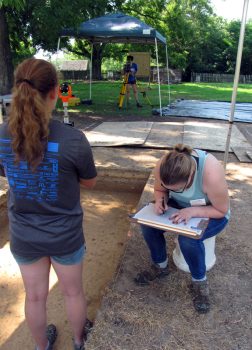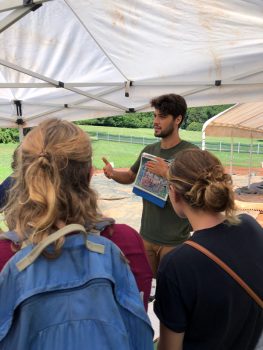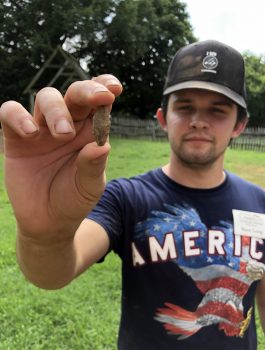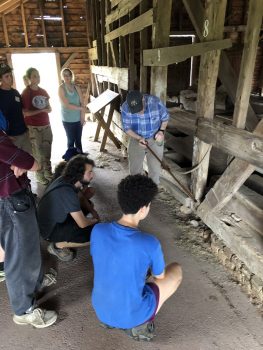Back to Dispatches from Field School
Field School 2018 – Week 9 (Part 2)
Olivia Redmond — St. Mary’s College of Maryland
“A Week of Learning”

Field school students Eva Miller (left), Shaelyn Harris, and Olivia Redmond (right) draw features in an excavation unit
The end of Week 9 of Historic St. Mary’s City field school featuring screening, troweling, and drawing on site among other academic activities including the much anticipated and originally delayed trip to Montpelier in Virginia.
Beginning at the Calvert House site, we spent the first day screening the soil leftover from Tidewater Archaeology Weekend. In one of the first screens of the day, my favorite artifact of the week was found: pieces of a 19th-century transfer-printed plate from the Brome Howard House when it was located in what was the yard of the Calvert House. Throughout the week, we found many types of artifacts: metal objects, ceramics, pipe, coal, brick, and lithics. On Friday, I worked on drawing features for a unit on the northeastern side of the site. It was a challenge for me to draw them, but nevertheless I persevered creating the foundation for the rest of the drawing.
On Wednesday afternoon, we hosted an archaeologist named Charles Fithian who
gave a lecture about his time working in marine archaeology and with material culture. Material culture is a term that describes what we can learn about people who lived in the past through the materials they used such as cloth, buttons, beads, etc. Fithian explained how the material artifacts they found from the ship, the HMS DeBraak, can be used to understand the crew through their material culture.
Material culture was seen in Montpelier; it affects the research, field work, and how we understand the lives of the enslaved people who lived at James and Dolley Madison’s residence. Material culture is important in studying artifacts identified from slave quarter sites because of the lack of a written record of the enslaved Africans. We can learn from their familial oral histories and what is observed from their artifacts using the concept of material culture. It is essential because it allows us to learn about their everyday lives, information that may have been lost in time without this important concept.
On Friday afternoon, we went on vernacular architecture tour in Historic Saint Mary’s City where we looked at the Godiah Spray Plantation, the Mackall Barn, and the Brome-Howard House to see how vernacular architecture has changed across the 17th, 18th and 19th centuries. Material culture is very important in a very literal sense when looking at architectural structures because you can observe how methods of building change over time, how the structures become more permanent, and some aspects of colonists’ lives like economic status. We visited the Brome Slave Quarter and the Brome-Howard House and learned about how their quarters changed as the enslaved Africans began to gain more freedom after emancipation. At the Brome Slave Quarter, the importance of oral history was shown in attempting to construct the best possible replica of the slave quarter’s evolution before being acquired by the museum. Without the oral history from the last family to live there, we may have not known how the house was changed from the late 18th century and early 19th century to the mid to late 20th century. Similarly, at Montpelier, an exhibit called a mere distinction of colour wouldn’t have been as powerful without the oral histories and knowledge from the descendants of the enslaved Africans that lived on the Madison property.

Montpelier Archaeology Crew Chief Chris Pasch (HSMC Field School Class of 2012) giving a tour of the excavations at Montpelier
In its entirety, this week was chock full of learning: learning to draw features on site, learning about other archaeological institutions’ methods of operating and presenting information to the public, learning more about HSMC’s methods of presenting information to the public, and the interdisciplinary use of material culture and oral history throughout the discipline of archaeology. Week 10 is the last week of field school. We will likely be working on finishing closing off units and working on as many areas as possible on the site while frantically (hopefully not so frantically) studying for our final exams.



